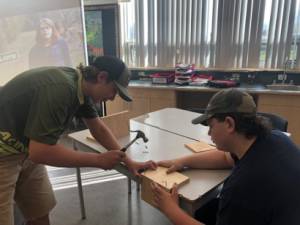
Thanks to the support of our generous funders and donors, Wildsight environment education programs have reached over 70,000 students ages 5 to 18. These programs help build a more sustainable future for all, empowering the students of today to be the leaders of tomorrow.
Right now, over a dozen EcoStewards projects—one of Wildsight’s key education programs—are taking place throughout the Columbia Basin. EcoStewards projects are guided by the passion and interests of each class, deepening both student and teacher connections with their wild backyards.
This spring, Janelle Park—one of Wildsight’s Educators—and students from Fernie Secondary School made buzzworthy news with their mason bee house building and bee release Ecostewards project. As bee populations continue to struggle, students got to “beesnus” on a project to help support native bees. Through the EcoStewards project, students learned about their local bee pollinators, built a habitat for them, and released the bees at two city parks, the local EcoGarden, and at the homes of five students and two teachers.
Wildsight sat down with our Janelle to learn more about her work with Wildsight.
W. How long have you been delivering the EcoSteward program? Are there any projects you’ve completed with students that really stand out?

J. This is my second year delivering EcoSteward programs for Wildsight. Last year we worked with the Elk River Alliance and Isabella Dicken Elementary School in Fernie to create a Western Painted Turtle nesting site in a local wetland. It was wonderful project. The students learned about species back from the brink, focused in on local species at risk and then worked to enhance a habitat for the turtles.
All the students enjoyed all the hard work involved. One of the things we worked on was creating a basking log in a sunny spot. We carried the thick tree as a team using webbing to hold it up. It was a tough job. I got a text the day after the project was completed that was a photo of a turtle and some ducks sharing the basking log. It is amazing to see what you have worked hard to accomplish being valuable.

W. This year your students chose mason bees as the basis of their project. Why were your students motivated to do a project on bees?
J. The classroom teacher presented multiple options to her class and they took a vote and decided on bees. Bees have had a hard go lately with habitat loss and climate change. The students saw the chance to learn and help a species on the decline.
W. Climate strikes have been occurring globally, thanks in part to climate activist Greta Thunberg. Have you noticed a shift in student’s motivation to take climate action? How do you keep your students upbeat and optimistic about the earth’s changing climate?
J. First and foremost, I try to help students love the magical planet we call home. If we love our planet and are able to see how perfect its balance is, we are more likely to make choices to help protect and preserve it. My favorite is when you help students discover something amazing about nature that they never knew existed or didn’t understand.
It’s these “wow” moments, like when students first take a really close look at some bark and realize that there are five varieties of lichen on it, or when they first see a dragonfly nymph and realize that it will soon emerge and fly away are what connects students with our natural world.
W. Thanks, Janelle!
Wildsight would like to recognize our generous funders who made the EcoStewards projects possible: Columbia Basin Trust, the Government of British Columbia, Fortis BC, Teck Coal, and Columbia Power. Thank you!







